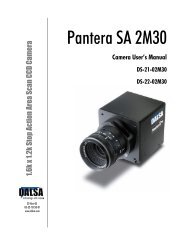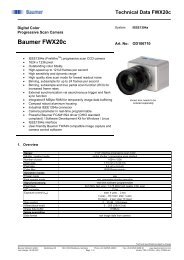TR-33 TR-34 TR-35 Trillium Rhino User's Manual - Frame Grabbers
TR-33 TR-34 TR-35 Trillium Rhino User's Manual - Frame Grabbers
TR-33 TR-34 TR-35 Trillium Rhino User's Manual - Frame Grabbers
You also want an ePaper? Increase the reach of your titles
YUMPU automatically turns print PDFs into web optimized ePapers that Google loves.
18 <strong>Trillium</strong> User’s <strong>Manual</strong><br />
2.5 RS232 Inputs<br />
This allows you to trigger camera functions from your frame grabber or other<br />
controller.<br />
User2, User3, User4 (RS232)<br />
These signals are user-configurable single-ended inputs with RS232 thresholds.<br />
They can be used to trigger camera functions that have been previously<br />
programmed through the serial interface. This allows you to trigger camera<br />
functions from your frame grabber or other controller without connecting to a<br />
PC.<br />
The camera accepts RS232 inputs on a standard DB9F connector. See Appendix C<br />
for protocol and command structure details.<br />
2.6 Pushbutton Input<br />
The camera’s pushbutton, located on the upper left corner of the backplate,<br />
triggers software commands. The factory default setting is a white light<br />
calibration (equivalent to the command correction_calibrate 2). The<br />
button’s function can be customized to any command through the serial<br />
interface. See Chapter 3 for details.<br />
2.7 Iris Control Outputs<br />
2.8 Data Outputs<br />
The camera's 6-pin iris control connector is designed to output control signals to<br />
a motorized iris. The camera has an embedded controller that can adjust lens<br />
aperture from a maximum of f/1.4 to f/22.4 assuming the use of a DALSAsupplied<br />
1K lens. The 2K lens aperture range is f/2 to f/16.<br />
See section 2.3<br />
for pinouts.<br />
Digital Data<br />
The camera uses 10-bit ADCs and outputs the most significant 8 bits (one<br />
channel for each color) in LVDS format. To clock digital data into the frame<br />
grabber, use the camera outputs clocking signals S<strong>TR</strong>OBE and LVAL.<br />
IMPORTANT:<br />
This camera’s<br />
data is valid on<br />
the rising edge<br />
03-32-10119-03 of S<strong>TR</strong>OBE.<br />
DALSA
















